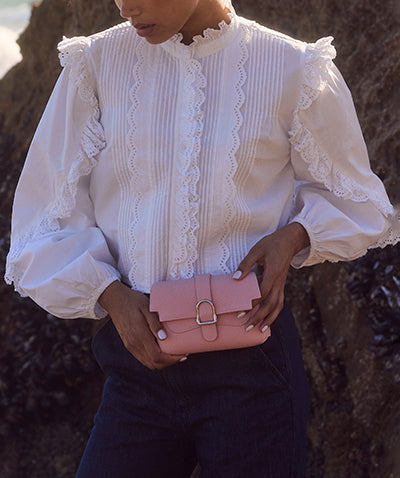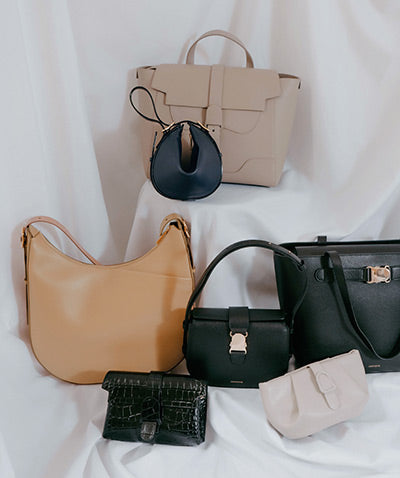Gift Note Edit
${ cartNote }
${ GWbtnTxt() }
Add offer code at checkout.
Shipping
Free
Subtotal
${ formatMoney(cart.total_price) }
Due Today
$0


See details.
Sustainable Fashion: What It Is and Why It's So Important
SENREVE is dedicated to a mission for a healthy and sustainable future, and we produce luxury handbags that are sustainable from the start. You can read more about our entire sustainability process, along with our sustainability plans for the future here. We just hit one of our first sustainability goals, which was releasing our 100% Vegan collection, which you can shop here. To learn more about sustainability in current fashion, read on.
What is sustainable fashion?
By definition, sustainable fashion is any type of fashion that uses textiles which are manufactured and marketed in a responsible way. Both the environmental and the socioeconomic impacts are taken into consideration across the garment’s entire life cycle, from the material sources and production to the disposal of the product.
More so, a company that practices sustainability usually has specific, written policies that take into consideration each of these areas, with the overarching goal to treat the planet and the people making the products more fairly, while implementing certain practices that reduce impact to the environment, whether through raw material sourcing, the actual manufacturing process, or the disposal of waste.
There are many forms of sustainable fashion, and no product or company is ever perfect. In order to understand what sustainable fashion really means and why it’s important, you first need to understand the buzzwords that are often thrown around as well as the different types of sustainability practices companies can adopt.
Read on to learn more about sustainable fashion and why you should care about it.
Terminology Cheat Sheet
- Eco-friendly: A product made with minimal impact to the environment or planet.
- Ethical: Usually used as an umbrella term that means the people that created the product were paid a fair wage and worked in a safe environment.
- Fair Trade: This simply means it was made by someone in an underdeveloped country, and that person was paid a fair, working wage.
- Organic: This means that the organic material made to produce the product, like cotton, was grown without using chemicals.
- Recycled: Perhaps the most obvious, this means the product was made by re-using another type of product such as rubber, plastic or fabric.
- Sustainable: Usually used to cover the terms eco-friendly and ethical, this means that the environment and the workers’ safety and wages were taken into account.
Types of Sustainable Fashion
1. Green & Clean
This means that the garment was designed and manufactured in a way that was environmentally conscious. The origin of the fiber and even the dye is taken into consideration in order to protect both the environment, the people creating the product, and also the people who wear the product. Ultimately, the goal with this style of sustainability is to expose the world to fewer harmful chemicals overall.
2. Fair & Ethical
In this case, the product is manufactured with animal rights in mind. In many cases, companies who practice fair and ethical manufacturing are open to detailing their entire supply chain, highlighting how they source the product and the environment in which the product is manufactured. They often promote the preservation of cultures and traditions across the globe.
3. Rented, Loaned or Swapped
This practice is more often adopted by individuals versus corporations. Rather than buying brand new products, people who adopt this policy often exchange or swap clothing with others. There are some companies that have a practice similar to this. Rent the Runway, as an example, is a designer gown company that rents dresses out for special occasions. Ultimately, this means the product is getting more use over its lifetime.
4. Repaired, Redesigned or Upcycled
Any garment that is mended or altered falls into this category. Like the above practice, this is designed to get the most value out of the product over its entire lifetime. It's important to note that only products that are of high quality are able to be repaired or upcycled. Those with lower quality will not last long enough for this to even be an option.
5. Secondhand or Vintage
As the name suggests, there are garments that have been previously owned and are being re-sold. They, like several of the above options, support an extensive product life. This is a popular market when it comes to high end clothing and designer handbags.
6. High Quality & Timeless Design
These are essentials any garments that are specifically designed with durability in mind. They may be more expensive up front, but are worth it as the cost per wear or cost per use actually lowers the true cost to below zero over time. Genuine leather products fall squarely into this category as they combine high quality with a timeless style.
7. On-Demand or Custom Made
These are garments that are made only when they are ordered. For example, custom furniture or specifically tailored clothing especially common dresses for weddings, fall into this category. Rather than being mass produced and taking up space, these products are only created when someone purchases them. This reduces waste overall and means that manufacturers can purchase the exact right amount of raw material.
8. Domestically Produced
These are products produced in the same country in which they are sold. However, a tag that says “Made in the USA” does not necessarily equate to a sustainable product. Be sure to read the label and do your research thoroughly for a full understanding of the practices that went into manufacturing and whether or not the company is partaking in environmentally friendly processes.
9. Fast Fashion’s Role in Sustainability
Fast fashion is a buzzword in the fashion industry today. Fast fashion can generically be defined as cheap, trendy clothing that has a high turnover rate in order to keep up with ever changing trends.
The goal in fast fashion is to more quickly move trends from the runway into the stores while being agile enough to keep up this process continuously. Fast fashion uses rapid production techniques with low-quality material in order to bring inexpensive styles en masse to the public.
As discussed above, a sustainable garment is one that is high quality, durable, and can last a lifetime. Fast fashion, then, is counter to the idea of sustainable fashion and more often than not results in harmful outcomes to the environment.
Up until a few years ago, brands usually operated on a 4-season cycle. Now, with the rise in fast fashion, brands are producing as many as 52 micro seasons’ worth of products in a single year, which equates to at least 1 new collection per week. Many popular brand-name companies are getting almost daily shipments of new products and inventory. As you would expect, as the need for production capacity increases using lower quality raw materials helps to offset the overall cost while still leaving the final customer with an affordable and inexpensive product that would likely only be worn a few times. It’s expected that products are thrown away after a few years and the idea of easy come, easy go has been perpetuated among society.
It’s not a secret that many brands in the fast fashion industry use cheaper, toxic chemicals and dyes to create their products and often use synthetic materials as well. Every year, millions of tons of these garments are simply thrown away, never to be used again. This means that these products that are full of chemicals are simply tossed into a landfill where they will spend eternity due to their inability to biodegrade.
The Importance of Slow Fashion

The future of the fashion industry is a concept known as slow-fashion, which takes into consideration everything negative about fast fashion and puts environmental and ethical considerations first.
When you buy a new fashion product, no matter what it is, you are telling the world what you value. When you buy from a responsible brand, you are not only helping the environment, you are signaling that sustainability is important to you, which is a key input to the slow fashion movement overall.
Bottom Line
When it comes to fashion, the sustainable practices of brands are of utmost importance. A truly sustainable product is one that can be upcycled, repaired, reused, and even resold due to its high quality and overall durability, extending its lifespan and the overall value it is able to create.
Sustainable business practices should be a consideration for all of us before we purchase. Be sure to do your research on the company and understand all of the jargon thrown around in the industry.
In order for truly sustainable practices to become the norm, every consumer must have a shift in their mindset and remember the caring for the planet is about forming a relationship based on true reciprocity. When it comes to consumerism, the easiest way to make your position known is by how you spend your money. Voting with your wallet and choosing to only purchase high quality, sustainable goods as a standard practice is the first step towards moving the fashion industry as a whole into the future.


